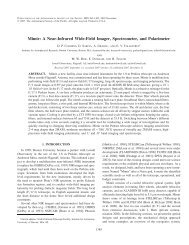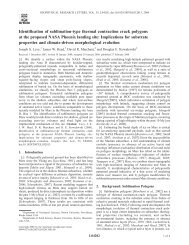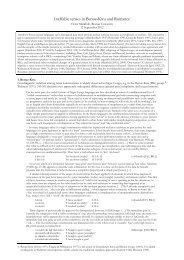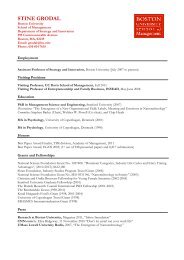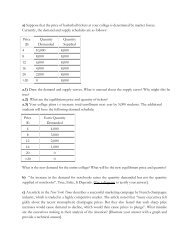Intertemporal Substitution and Recursive Smooth Ambiguity ...
Intertemporal Substitution and Recursive Smooth Ambiguity ...
Intertemporal Substitution and Recursive Smooth Ambiguity ...
You also want an ePaper? Increase the reach of your titles
YUMPU automatically turns print PDFs into web optimized ePapers that Google loves.
As in KMM (2005, 2009a), we impose the last axiom that connects preferences oversecond-order acts <strong>and</strong> the original preferences over pairs of current consumption <strong>and</strong> continuationcompound lottery acts. In doing so, we introduce the notion of one-step-ahead act–acompound lottery act in which subjective uncertainty resolves just in one period. We thenconstruct a second-order act associated with a one-step-ahead act, that maps a probabilitymeasure on S to a compound lottery on the consumption space. This compound lottery isobtained by averaging out states in the one-step-ahead act using the probability measure onS. The last axiom says that the decision maker orders pairs of current consumption <strong>and</strong> theone-step-ahead act identically to the second-order acts associated with the one-step-aheadacts. The intuition is that the decision maker’s ranking of the former choices reflects hisuncertainty about the underlying distribution of the choices, which is the domain of thesecond-order acts.One critique of the KMM (2005) model raised by Seo (2009) is that second-order acts<strong>and</strong> preferences over second-order acts are typically unobservable in the financial markets.For example, investors typically bet on the realization of stock prices, but not on the truedistribution underlying stock prices. A similar critique applies to the Anscombe-Aumannacts as well because these acts are also unobservable in financial markets: the realizations ofstock prices are monetary values, not lotteries. However, both Anscombe-Aumann acts <strong>and</strong>second-order acts are useful modelling devices <strong>and</strong> available from laboratory <strong>and</strong> thoughtexperiments. 8 More concretely, when measures in P s t correspond to conditional distributionsindexed by an unknown parameter as in (3), the second-order acts are bets on the value ofthe parameter. In an asset pricing application studied by Ju <strong>and</strong> Miao (2010), P s t consists oftwo distributions for consumption growth in a boom <strong>and</strong> in a recession so that the secondorderacts are bets on the economic regime. In a portfolio choice application studied byChen, Ju <strong>and</strong> Miao (2009), P s tconsists of two distributions for the possibly misspecifiedstock return models so that the second-order acts are simply bets on the statistical modelof stock returns.It is possible to dispense with the auxiliary domain of second-order acts following Seo’s(2009) axioms. Building on his insight, we provide an alternative axiomatization for (2)modelling devices to deliver Ellsbergian choices on the state space S of primary interest. To accommodateEllsbergian choices for second-order acts, one can simply exp<strong>and</strong> the state space to incorporate measures onS.8 To further illustrate this point, we quote Kreps (1988, p.101): “This procedure of enriching the setof items to which preference must apply is quite st<strong>and</strong>ard. It makes perfectly good sense in normativeapplications, as long as the Totrep involved is able to envision the extra objects <strong>and</strong> agree with the axiomapplied to them. This need be no more than a thought experiment for Totrep, as long as he is willing to saythat it is a valid (i.e., conceivable) thought experiment.”5



